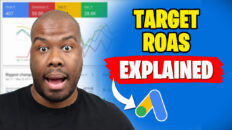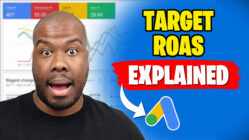Transcript
When you start a brand new campaign on Google Ads, the one of the first choices you have is deciding on which bidding strategy to go with. And it’s a really important choice because choosing the wrong bidding strategy could mean your campaign is set up for success or set up for failure. So in this video, we’re going to compare two bidding strategies.
In particular, we are going to look at a maximize. impression share bid strategy and see how that weighs up against a maximize clicks strategy. Because these two strategies, believe it or not, are actually quite similar and are trying to achieve similar goals. So let’s break down what these strategies are, how to use them, and which one is best for your business.
And should you even be using these two strategies in particular? Both of these bidding strategies in particular are what I like to call vanity strategies because Generally speaking in Google Ads when you’re spending money on a platform like this, you want the objective to be something focused around leads or revenue.
If you’re not generating leads like a phone call or a contact form submission or generating sales directly on your website. then you’re not really putting your budget to the best use using a bottom of funnel, direct response platform like Google ads. But it’s not always a bad idea to use a bit of vanity from time to time.
So these two strategies are focused around purely visibility and traffic, which are not. conversion and revenue focused. So there’s where the similarity lies between these two strategies and that is why quite often people like to compare them. Let’s start off with target impression share. Now this kind of bidding strategy means you are essentially guaranteeing that your ad will serve for every single relevant search.
for a given cohort of keywords in your campaign. An impression in Google Ads is essentially when somebody sees your ad on the Google search results page. So if they go in, type something into Google that triggers your ads to show, when they see your ad on the results page, that is one impression. So naturally speaking, a target impression share is essentially deciding How often your ads will show versus how many times a user could have triggered your ads.
And with this bidding strategy, you have a few controls. You can say to Google, I want to show 100 percent of the time whenever somebody types something into Google that would trigger my ads. I want to be visible 100 percent of the time. You can actually program this into the bidding strategy to maximize visibility in your campaigns.
As you can imagine, this is quite an expensive exercise because what you’re saying to Google at that point is, I don’t care how much the auction costs. I don’t care how competitive it is. I don’t care how much I’m eventually going to pay for the click I get from the visibility. I want to show every single time, which is why Google has put a control in place where you can actually set.
a max CPC bid on your target impression share. Now, of course, if you set this too low, Google might struggle to reach your target impression share. So maybe you want to show again for 100 percent of searches. If you set your max CPC bid too low, then ultimately Google will refuse to serve your ads because it’s not competitive enough to serve in the more competitive auctions.
So you will not be able to achieve your high impression shares. You also have another control where you can say to Google, I want to be at the absolute top of the page. So instead of being in anywhere on the page, in terms of having 100 percent impression share, where if you’re on any position on the search results page, Google will count that as 100%, you can say you want to be at the top of the page, guaranteeing even better visibility.
Again, quite an expensive exercise. So target impression share focuses around visibility on the search results page before the click. But then maximize clicks goes the other way. And what you’re doing with this strategy is saying you want Google to get as many clicks to your website from your keywords as possible within your budget.
So what Google is going to do with your budget is understand how much it has to play with. And then based on that, it will use click data to kind of see how many clicks it could get for your budget. Now, naturally speaking, if your budget is low or middling, then it’s going to be quite restrictive in the kinds of auction it can enter to maximize your clicks.
Because if you enter a really competitive auction, all of your budget will go on just a handful of clicks and Google would not meet your objective of maximizing your clicks. There is actually another control you have on this bidding strategy where you can say to Google, let’s set a maximum CPC to make sure I don’t go too crazy.
Spending a ridiculous amount of money on a particular click and maximizing your CPC means you have an additional control, but again, Google will not be able to get much traffic for you and hit that click objective. If you set your max CPC too low, because it can’t enter the number of auctions available to it.
If you set it too low, it just won’t be competitive. enough. So now you have a good understanding of both of these bid strategies. Which one should you be using and when? Well, if we stick with max clicks, the time to use this kind of bidding strategy is if you’re a budget strapped business and you can’t compete in some of the really high level expensive auctions available in your kind of niche or market.
Max clicks could be a good way to start getting traffic to your website, start understanding what kind of quality of traffic you can generate through Google Ads in a much more cheap way than you would if you were entering a more competitive bid strategy like target ROAS or target CPA with a maximized conversions bid strategy.
So it’s a cheap way to get traffic and understand What kind of traffic you can generate on Google Ads. Sometimes you can start a brand new campaign with this strategy in the data gathering process to kind of see what type of searches you can get for your budget. Then you have target impression share.
When would you use a strategy like this? Well, the best time to use this strategy is if you’re using a brand campaign and you’re bidding on your own brand, you can maximize your visibility for your own brand name. The benefit of this as well is because it’s your brand name and your website is geared up for your brand, of course, you’re going to pay less for your clicks.
It’s going to be a cheap campaign, and even if you target a 100 percent impression share at all times, it won’t be too costly. And it means you can basically not worry about the bids you’re setting for your brand campaign. Google will always try to achieve your objective. of maximizing your visibility for your brand name.
I have seen one other use case for this bid strategy and it’s if you’re running a campaign using target CPA with a maximized conversion strategy or using a target ROAS strategy and you’re finding a very specific keyword and search term more importantly is driving a lot of revenue and you want to maximize the the value you get from this keyword.
You can sometimes put that keyword into a target impression share campaign maximize visibility on it. Use negative keywords in its own campaign to make sure you’re only getting visibility for that particular keyword. And what that’s going to do is guarantee visibility at the highest level for a keyword you have known and is proven to work.
And then you’re going to get loads more conversion, sometimes more so than if that keyword was in the original campaign it came from, amongst other keywords, because it’s going to guarantee the budget and visibility behind it. And it means sometimes You can get more conversions using this strategy. So it’s not necessarily always about vanity, but ultimately that is the main reason these two bidding strategies are compared to each other because they are non revenue and lead focused, which means they’re all about visibility and traffic and kind of the things.
Not necessarily focused around business goals and objectives. Which one you choose for your business, I’ve given you a couple of use cases, will depend on where your business is at, what kind of campaign it is. But essentially, that is the ultimate way to compare these two bidding strategies. One is about click volume, one is about visibility, how you use them depends on the individual use case for your business.
However, let me just caveat this strategy, because if you’re using either of these two strategies I mentioned as your primary, Bidding strategy where most of your spending Google Ads is going through you’re probably going to be missing out on conversions because they are non business focus and in reality You should be in a position where you’re pushing your spend through a campaign that maximizes conversions or revenue in your business But what do you think have you used either of these strategies before let me know in the comments whether or not they worked well For you or whether you they don’t maybe you’re thinking of using these strategies Let me know if you need help setting them up.
I reply to pretty much every comment I get on all of my new videos. Like this video. If you like it, don’t forget to subscribe, check out the other content across my channel, and I’ll see you guys on my next video.







